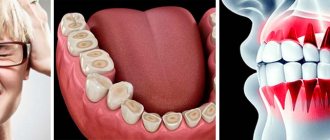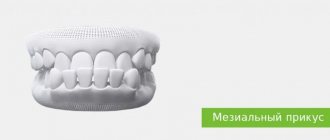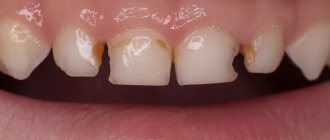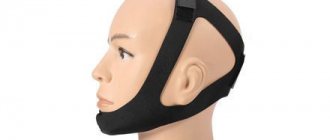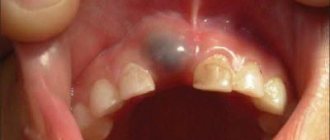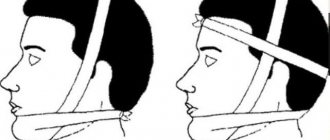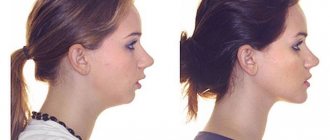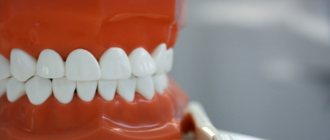Progeny is a deviation from the norm in the structure of the dentition. It is expressed in enlargement and protrusion of the lower jaw. Such pathological deformation occurs statistically in the range of 1.4 - 30% of patients.
External signs:
In addition to a protruding lower jaw, patients with pathology experience:
- recession of the face in the middle part;
- thickening of the lower lip relative to the upper, its protrusion, and sometimes inversion;
- deepened nasolabial folds;
- increased angle between the lower and upper jaw.
Varieties
In orthodontics there is a classification according to which there are two types of progeny. More details about each of them:
- True. The location of the anterior and lateral dental units is disturbed. A gap forms between the jaws. The defect can be corrected without surgery only in childhood.
- False (senile). The anomaly affects only some central teeth. Occurs mainly in elderly people.
Types of prognathia:
- True prognathia. This type of pathology is rare. The upper jaw is abnormally large. Restoring normal proportions is possible only in children through the use of the Frenkel apparatus.
- False prognathia. The lower jaw sinks deeply. Treatment is orthodontic or surgical.
A – setting of teeth with progenia, b – with prognathia
Correction of pathology
The choice of treatment tactics for this condition directly depends on its form. However, it should always focus on eliminating as well as preventing possible complications.
The goals of treatment are:
- Moving the jaw in the right direction.
- Increased growth of the upper jaw.
- Treatment of problem teeth.
It is worth noting that the choice of treatment tactics directly depends on the age at which it begins.
In a milky bite
In this case, therapeutic measures are used in combination with the prevention of complications. The most commonly used methods include extraoral dressings and myogymnastics.
The main function of the extraoral bandage is to restrain the growth of the lower jaw, as well as fix it in the correct position.
Use of the device is recommended only at night. It is a sling, which is fixed with two elastic bands passing through the articular surfaces.
The correct functioning of the muscles surrounding the dentition helps to form a physiological bite. A greater effect can be achieved from this if you start special gymnastics at a young age.
There is a whole set of exercises, which includes:
- Lower lip grip.
- Using a spatula. It must be inserted into the oral cavity so that one end touches the back surface of the incisors. After this, the child closes his mouth, and the stick acts as an inclined surface.
- Posterior movement of the lower jaw. The mouth must be closed.
Before starting special exercises, it is recommended to carry out breathing exercises and other exercises to improve nasal breathing.
The duration starts at 10 minutes and gradually increases. It is recommended to do the exercises twice a day. It is important to understand that with a later start of treatment, this method is largely auxiliary and should not form the basis of treatment measures.
In a mixed bite
During this period, the use of special devices is recommended:
- The Brückle apparatus is a special plate that is temporarily installed on the problem jaw. It is a device that operates in combination. The purpose of using this treatment method is to eliminate the incorrect inclination of the front teeth.
- In some cases, experts recommend combining the device with a sliding screw. This is necessary if there is severe crowding of the lower front teeth.
- Kappa Bynina operates on the same principle, but is used in more severe cases.
During a mixed dentition, it is more difficult to deal with the problem than at an early age, but the effect is achieved relatively quickly. Treatment is always more difficult after the child’s bite is completely formed.
In permanent bite
During permanent dentition, the main treatment method is the Engel arch. Such an arch, when installed on the upper and lower jaw, allows you to move the latter in the distal direction. It also has a stimulating effect on the growth of the upper jaw in the desired direction.
In addition, it is recommended to use complex treatment. Often it is necessary to resort to surgical techniques. A popular type of complex therapy in this case is the compression method. In this case, the compression rate should be 0.2 mm no more than once a day.
In some cases, compactosteotomy may be performed. The advantages of this method are:
- Partial violation of the integrity of the lower jaw.
- No effect on blood vessels and nerves.
- Preservation of lower jaw function for the entire duration of treatment.
- There is no need for the patient to be in a hospital.
Thus, the choice of treatment method depends not only on the cause of the pathology, but also on the age of the patient.
In the video, see the principle of correcting a progenic bite with a plate.
Causes of progeny and prognathia
All children are born with a distal malocclusion. But in the process of natural feeding, the child actively trains the lower jaw, and over time the bite becomes normal.
At older ages, prognathia occurs for the following reasons:
- artificial feeding;
- prolonged pacifier sucking;
- mouth breathing (for chronic ENT pathologies);
- previous rickets;
- early removal of baby teeth;
- incorrect posture;
- incorrect position of the body and head during sleep.
Progeny can develop due to congenital or acquired factors. Here is a complete list of reasons:
- unfavorable heredity;
- taking certain medications during pregnancy;
- severe illnesses suffered by the mother while carrying a child;
- birth injuries;
- underdevelopment of the jaw bone;
- pathology of the alveolar processes;
- bad habits (finger or upper lip sucking);
- long-term use of the pacifier;
- respiratory system diseases;
- late change of teeth;
- macroglossia (too large tongue);
- complications after surgery in the maxillofacial area.
Causes of mesial bite
In the early stages of development:
- genetic predisposition - congenital anomalies in the structure of the skull and facial bones occur;
- illnesses suffered during pregnancy, deficiency of vitamins and nutrients, living in unfavorable conditions;
- increased size of the child's tongue;
- pathologies of the thyroid gland, rickets;
- short frenulum, improper breastfeeding.
During the period of milk and permanent teeth:
- insufficient wear of primary teeth in children 3-6 years old;
- premature loss of teeth in the upper jaw due to caries or impact;
- late appearance of teeth on the upper jaw;
- bad habits - resting your chin on your hand, sleeping in a position with your head bowed to your chest.
Most often, abrasion is disrupted on temporary canines due to the late period of physiological change. This prevents the closure of the dentition, and therefore mesial occlusion is formed. The correction scheme depends on the severity of the deformity. Therefore, PROPRICUS dentistry uses several treatment methods. The patient undergoes a detailed diagnosis by several specialists to understand how to correct the mesial bite.
Symptoms
Progenia is characterized by certain clinical symptoms. Here are the main signs:
- the lower part of the face is voluminous and high;
- chin narrowed or pointed;
- upper lip flattened;
- lower lip slightly turned out;
- pronounced nasolabial folds;
- facial asymmetry;
- absence of a fold under the lower lip;
- elongated nose;
- problems with diction (most often a lisp);
- violation of chewing function;
- teeth have different positions and grow in different directions.
Mesial overbite is common in children, but is rare in adults (after 20 years).
With prognathia, the following symptoms are observed:
- half-open mouth;
- underdevelopment of the lower jaw and its shift back;
- the presence of a longitudinal gap between the incisors of the upper and lower rows;
- visually reduced lower third of the face;
- difficulty mouth breathing;
- diction defects.
The patient’s appearance and the relationship of teeth with progeny
Correction of bite during progenia
The choice of correction methods depends on the type of pathology and the causes of its occurrence. The orthodontic appliances used stimulate the development of the upper jaw and correct the position of the teeth. DaVinci studio dentists use:
- mouthguards;
- trainers;
- plates.
These are less painful and long-lasting methods of correction. When starting treatment in adulthood, the braces system will help you achieve the desired result. Children wear them from one to one and a half years, while adults wear them for about four years.
Serious dental deformities in the absence of a desire to use braces are treated with surgical intervention in adulthood. Surgery is a financially expensive method associated with the risk of complications. Therefore, if a dentist recommends wearing orthodontic appliances, it is better to listen to the advice.
Consequences of progeny and prognathia
Sometimes people do not notice their malocclusion and live with it until old age. But existing violations have a negative impact on health. They contribute to the progression of a number of diseases.
Consequences of progeny:
- dysfunction of the temporomandibular joint;
- pathologies of the digestive tract (due to poor quality of chewing food);
- facial deformities;
- gum disease;
- early tooth decay;
- facial muscle spasms;
- problems with prosthetics.
Consequences of prognathia:
- Diction defects.
- Changing facial proportions.
- Difficulty brushing teeth. Tartar and plaque quickly form, which creates a favorable environment for the proliferation of pathogenic microorganisms.
- Thinning of bone tissue in certain areas due to uneven load on the teeth.
- High risk of developing dental diseases (caries, gingivitis, periodontitis).
Closing of teeth with true and false progeny
Methods for treating mesial occlusion
Aligners are one of the most practical, convenient, safe and effective correction methods. They are made from polymer materials according to the patient’s individual impression. Therefore, the risk of the structure shifting is completely eliminated. Aligners follow the anatomical shape of the teeth and jaw. They cannot be seen on the teeth due to the complete transparency of the trays. Patients observe minor defects within 2-3 days after installation. They do not interfere with chewing, drinking, or brushing your teeth. You should remove your aligners before performing oral hygiene and eating.
Sign up for free 3D modeling of your future smile!
Make an appointment
*By making an appointment you consent to the processing of your data
Advantages of aligners:
- do not stain;
- not visible to others;
- soft and elastic;
- safe for health;
One of the most advanced foreign bite alignment systems is Invisalign. This is an innovative product from an American company that is used in our clinic. Therapeutic mouth guards create pressure on the teeth, causing them to return to their normal position. We use only original products and are completely confident in the effectiveness of orthodontic treatment with aligners.
During the initial examination, the doctor assesses the condition of the patient’s oral cavity, diagnoses the condition of the jaw system, draws up a treatment plan and names its cost. Before the treatment plan is approved, the patient is shown what the oral cavity will look like after treatment. After agreeing on the details and signing the contract, the doctor performs sanitation of the oral cavity, if there is an indication for this. Therapeutic mouth guards take 2 weeks to make. The elements will have to be changed and will have to be changed every 2-3 weeks. The average duration of treatment with aligners is 6 months to 1.5 years.
How to fix
Progenia and prognathia can be corrected, but treatment methods may vary. In childhood, bones are pliable and respond well to therapeutic manipulation.
Methods for treating progeny in children:
- frenulum correction;
- use of occlusal pads;
- myogymnastics (muscle warm-up to optimize their functioning);
- massage of the alveolar process;
- use of plates and activators.
Devices for correcting bites
In adolescents, coping with the defect can be much more difficult. It takes more time and effort than with babies. They are indicated for orthodontic correction using braces, mouthguards or trainers. In parallel with this, it is recommended to visit a speech therapist (if there are problems with speech).
To eliminate the defect in adults, you can use the following products:
- arc devices with intermaxillary traction;
- Bruckle's apparatus;
- braces.
In difficult cases, surgical intervention is indicated. This could be a simple tooth extraction or surgery on the lower jaw.
To treat prognathism in children, specialists use devices that accelerate the growth of the lower row of teeth and inhibit the growth of the upper jaw. These include:
- activator tools;
- compression bandages;
- Frenkel apparatus.
In adults, distal occlusion is corrected with braces. If indicated, surgical intervention may be performed.
Methods for correcting mesial occlusion in adults
Mesial occlusion, which is detected before the age of 12 years, is more treatable. Unfortunately, this does not always happen and often adult patients seek help in correcting their bite. Conservative orthopedic methods for correcting occlusion are sometimes ineffective. Often teenagers and adults complain of pain and discomfort when installing a corrective structure. But at the PROPRICUS clinic they use the most effective methods. Serious defects can be corrected with veneers, aligners, and mouth guards. We treat mesial occlusion in adults even in the most difficult situations, when it seems that it is impossible to return the teeth to their normal appearance.
Prevention
To prevent progenia and prognathia, experts give the following recommendations:
- timely treat pathologies of the dental system;
- wean children from bad habits (sucking fingers, lips and others);
- control the position of the child’s body and head during sleep;
- monitor the child's posture.
Pregnant women need to be careful about their health. Proper nutrition with the required amount of vitamins and microelements is important. Also, you should try to protect yourself from infections and minimize stress. It is always easier to avoid violations than to deal with treatment later.
Timely detection of progenia and prognathia guarantees simpler and more effective therapy. Therefore, if you have symptoms of mesial or distal occlusion, you should not postpone a visit to the doctor.
Complications without treatment
In case of malocclusion, treatment is always necessary, since the pathology is not only accompanied by cosmetic defects, but can also cause various complications, which include:
- improper chewing load leads to rapid wear of tooth enamel, which causes increased sensitivity and the risk of premature loss;
- development of periodontal disease against the background of increased periodontal wear;
- problems with the digestive system due to poorly chewed food;
- underdevelopment of individual facial muscles and the appearance of painful sensations in them;
- premature tooth loss;
- difficulties associated with treatment - prosthetics and implantation.
Also, with an abnormal bite, problems with diction, jaw joints, and the rapid occurrence of infections in the oral cavity may occur. With timely and proper treatment, such complications can be completely eliminated.
